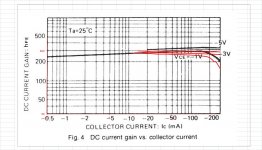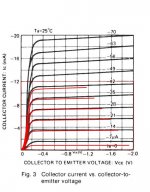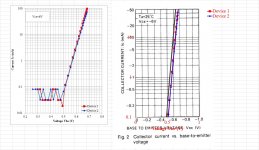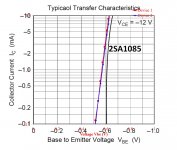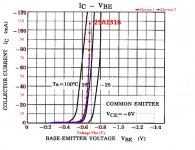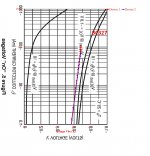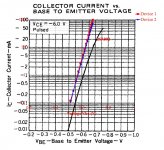Do you think you can get anymore 2SJ18? Looking for two.
Should be ok. Let me check and get back to you. Thx
When it comes to jfets, j74 is probably still one of the best options [emoji51] last batch of j74/j75 to be matched...no more stock after this one


2SB737 is a good low noise PNP transistor from ROHM. It has vanished from diy community for quite some time, as the production stopped quite long time ago. I just got some from a reliable source. Nowadays, even reliable source sells fake parts, plus B737 are really rare. Therefore, I did some measurement myself to check against the data sheet and verify whether these are genuine parts. Here are some plots. My measurement data are superimposed with plots from datasheets, so comparison between the two can be more clearly seen. Obviously, the parts I measured have very close curve as the data sheet.
selling unmatched at $4.5 each, $42 for 10. Matching service may be provided if demand is high😀 VERY limited stock

selling unmatched at $4.5 each, $42 for 10. Matching service may be provided if demand is high😀 VERY limited stock

Attachments
Last edited:
Yes, I agree that measuring noise is definitely the best way to verify this transistor. Unfortunately, I dont have the appropriate tool to do it, which is why I checked DC curves so carefully. I think a counterfeiter will not take all the trouble to make a fake to have DC characteristics so close to the real one, considering the low price of this part. We have been seeing how fake JFETs, like J74, perform all this time...
If any kind soul in this forum could kindly help measure the noise, I can provide 2 samples free of charge. just need to pay for the shipping and measure the noise. The transistors will be yours after that 🙂
If any kind soul in this forum could kindly help measure the noise, I can provide 2 samples free of charge. just need to pay for the shipping and measure the noise. The transistors will be yours after that 🙂
You need to measure noise.
Patrick
Good BJTs do not diifer much from each other, just JFETs do.
So noise measurement is the only way to tell for sure.
You can easily build a 1000x low noise amplifier with an AD8429.
The rest you can find out on the inet.
Patrick
So noise measurement is the only way to tell for sure.
You can easily build a 1000x low noise amplifier with an AD8429.
The rest you can find out on the inet.
Patrick
Hi Patrick, would you or anyone of your team be interested to test them? I can send some to you. 🙂
too much of a hustle to me to build a amp for such small quantity BJT. Profit I can make from them will probably be not enough for the material cost for the amp😀
too much of a hustle to me to build a amp for such small quantity BJT. Profit I can make from them will probably be not enough for the material cost for the amp😀
Good BJTs do not diifer much from each other, just JFETs do.
So noise measurement is the only way to tell for sure.
You can easily build a 1000x low noise amplifier with an AD8429.
The rest you can find out on the inet.
Patrick
There is a schematic of a noise measurement system here Low Noise Design Schematics and some measurements on transistors. But like Parick says - all you need is (a) a method of biassing the transistor and (b) a well-shielded high gain amp.
There was an HP transistor noise analyzer, the 4470B, that was full featured. But they tend to sell for large money on the rare occasion they come up for sale.
There was an HP transistor noise analyzer, the 4470B, that was full featured. But they tend to sell for large money on the rare occasion they come up for sale.
Hi Craig, thx for the infor. I guess I would try to see whether i could borrow a analyzer from someone in sg. Building an amp system is too troublesome and I dont really have time to do it now 😉
Pls share your build, after you get them 😀
Pls share your build, after you get them 😀
There is a schematic of a noise measurement system here Low Noise Design Schematics and some measurements on transistors. But like Parick says - all you need is (a) a method of biassing the transistor and (b) a well-shielded high gain amp.
There was an HP transistor noise analyzer, the 4470B, that was full featured. But they tend to sell for large money on the rare occasion they come up for sale.
ok, just some following up about B737. I was wondering whether good BTJ are really similar, so I compare the curves from the B737 and a few common BJT in the market. Here are the plots. Luckily, they look quite different 😀😀😀 Some have different ideality factor, some have different Vbe(on), etc...
Anyone knows other BJT which could have close Ic vs. Vbe to B737? I will be interested to compare them.
Anyone knows other BJT which could have close Ic vs. Vbe to B737? I will be interested to compare them.
Attachments
I'm not surprised that they are different. The exact form of the curves depends on the device geometry, semiconductor doping etc etc.
For a bipolar device used in low source impedance applications (like an amp for moving coil pick up cartridges) the main characteristic of importance is the base spreading resistance rbb' since this is the determining effective noise resistance. And you can't imply what this is from the usual characteristics.
For a bipolar device used in low source impedance applications (like an amp for moving coil pick up cartridges) the main characteristic of importance is the base spreading resistance rbb' since this is the determining effective noise resistance. And you can't imply what this is from the usual characteristics.
Quite true, we can't get how the rbb is from the simple DC measurement.
What I'm trying to see here is whether it is really that simple to match the BJT DC curves, though most BTJ DC curves may look similar at a glance. As it depends on many factors, length, width, doping, etc, as you said, it would be rather difficult to achieve a perfect matching for a counterfeiter. Matching a data point may be easy, but not the whole curve. Not really economically feasible to make fake this real at such low quantity and price...🙂
Considering the track record of the supplier of this transistor, the transistors are >99% real. I just want to have more evidence (my reputation is on the line, lol), without building an amp system for the noise thing.
Again, offer still stands for those who can help measure the noise🙂 free samples~~
Cheers [emoji482]
What I'm trying to see here is whether it is really that simple to match the BJT DC curves, though most BTJ DC curves may look similar at a glance. As it depends on many factors, length, width, doping, etc, as you said, it would be rather difficult to achieve a perfect matching for a counterfeiter. Matching a data point may be easy, but not the whole curve. Not really economically feasible to make fake this real at such low quantity and price...🙂
Considering the track record of the supplier of this transistor, the transistors are >99% real. I just want to have more evidence (my reputation is on the line, lol), without building an amp system for the noise thing.
Again, offer still stands for those who can help measure the noise🙂 free samples~~
Cheers [emoji482]
I'm not surprised that they are different. The exact form of the curves depends on the device geometry, semiconductor doping etc etc.
For a bipolar device used in low source impedance applications (like an amp for moving coil pick up cartridges) the main characteristic of importance is the base spreading resistance rbb' since this is the determining effective noise resistance. And you can't imply what this is from the usual characteristics.
I'm certainly looking at building a simple noise measurement system. Of course simple quickly becomes less so.
The voltage and current noise from a transistor is (a) frequency dependent, particularly at low frequency (b) depends on collector/drain current and hence (c) on the transistor gain.
So OK - now suddenly we need a piece of kit that does NPN and PNP bipolar and N-channel and P-channel JFETs at least. It need to have a method for changing the bias conditions (quite easy) and for normalising the gain.
This latter requirement HP did in a typically HP way. They injected a low level pilot tone into the base/gate, then used an AGC amp to set that to a fixed level. To then get rid of the pilot tone it uses a mixer and synchronous demodulation. All done with discrete transistors, because the only op-amps at the time were truly awful.
Coming up to the present day, the device gain can still be measured by injecting a 1kHz sine pilot tone, and measuring the amplitude at the output of a high gain amp. Then turn off the sine and just measure the noise, or display on a spectrum analyzer.
Of course you can get around the need for a pilot tone by calculating the gains by using formulae, easily measured DC parameters and the bias conditions.
The voltage and current noise from a transistor is (a) frequency dependent, particularly at low frequency (b) depends on collector/drain current and hence (c) on the transistor gain.
So OK - now suddenly we need a piece of kit that does NPN and PNP bipolar and N-channel and P-channel JFETs at least. It need to have a method for changing the bias conditions (quite easy) and for normalising the gain.
This latter requirement HP did in a typically HP way. They injected a low level pilot tone into the base/gate, then used an AGC amp to set that to a fixed level. To then get rid of the pilot tone it uses a mixer and synchronous demodulation. All done with discrete transistors, because the only op-amps at the time were truly awful.
Coming up to the present day, the device gain can still be measured by injecting a 1kHz sine pilot tone, and measuring the amplitude at the output of a high gain amp. Then turn off the sine and just measure the noise, or display on a spectrum analyzer.
Of course you can get around the need for a pilot tone by calculating the gains by using formulae, easily measured DC parameters and the bias conditions.
I'm certainly looking at building a simple noise measurement system. Of course simple quickly becomes less so.
The voltage and current noise from a transistor is (a) frequency dependent, particularly at low frequency (b) depends on collector/drain current and hence (c) on the transistor gain.
So OK - now suddenly we need a piece of kit that does NPN and PNP bipolar and N-channel and P-channel JFETs at least. It need to have a method for changing the bias conditions (quite easy) and for normalising the gain.
This latter requirement HP did in a typically HP way. They injected a low level pilot tone into the base/gate, then used an AGC amp to set that to a fixed level. To then get rid of the pilot tone it uses a mixer and synchronous demodulation. All done with discrete transistors, because the only op-amps at the time were truly awful.
Coming up to the present day, the device gain can still be measured by injecting a 1kHz sine pilot tone, and measuring the amplitude at the output of a high gain amp. Then turn off the sine and just measure the noise, or display on a spectrum analyzer.
Of course you can get around the need for a pilot tone by calculating the gains by using formulae, easily measured DC parameters and the bias conditions.
Great! I will provide two free b737 for the test!
- Home
- Vendor's Bazaar
- Selling Zhou Fang’s remaining stocks including some very rare Toshiba transistors



